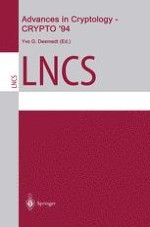The CRYPTO ’94 conference is sponsored by the International Association for Cryptologic Research (IACR), in co-operation with the IEEE Computer Society Technical Committee on Security and Privacy. It has taken place at the Univ- sity of California, Santa Barbara, from August 21-25,1994. This is the fourteenth annual CRYPTO conference, all of which have been held at UCSB. This is the first time that proceedings are available at the conference. The General Chair, Jimmy R. Upton has been responsible for local organization, registration, etc. There were 114 submitted papers which were considered by the Program Committee. Of these, 1 was withdrawn and 38 were selected for the proce- ings. There are also 3 invited talks. Two of these are on aspects of cryptog- phy in the commercial world. The one on hardware aspects will be presented by David Maher (AT&T), the one on software aspects by Joseph Pato (Hewlett- Packard). There will also be a panel discussion on “Securing an Electronic World: Are We Ready?” The panel members will be: Ross Anderson, Bob Blakley, Matt Blaze, George Davida, Yvo Desmedt (moderator), Whitfield Diffie, Joan Feig- baum, Blake Greenlee, Martin Hellman, David Maher, Miles Smid. The topic of the panel will be introduced by the invited talk of Whitfield Diffie on ”Securing the Information Highway. ” These proceedings contain revised versions of the 38 contributed talks. Each i paper was sent to at least 3 members of the program committee for comments.
